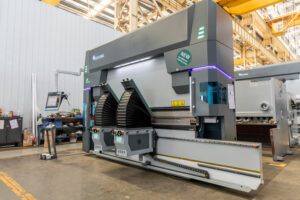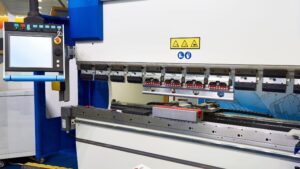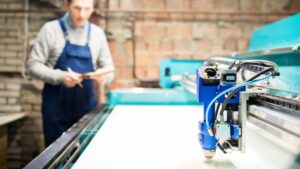Press brake tooling selection is crucial to get the correct results from any sheet metal bending operation. Press brakes have become integral in almost every modern metal fabrication industry. Due to the huge popularity and wide applications, there are many different options for press brake tooling to suit various lengths and shapes of bends.
This article will explore through the details of press brake tooling selection. The information presented here is useful for both beginner press brake operators and even experienced professionals in the field. You will learn about the press brake tooling materials, style options, various types, and important parameters for choosing press brake tooling.
What is Press Brake Tooling?
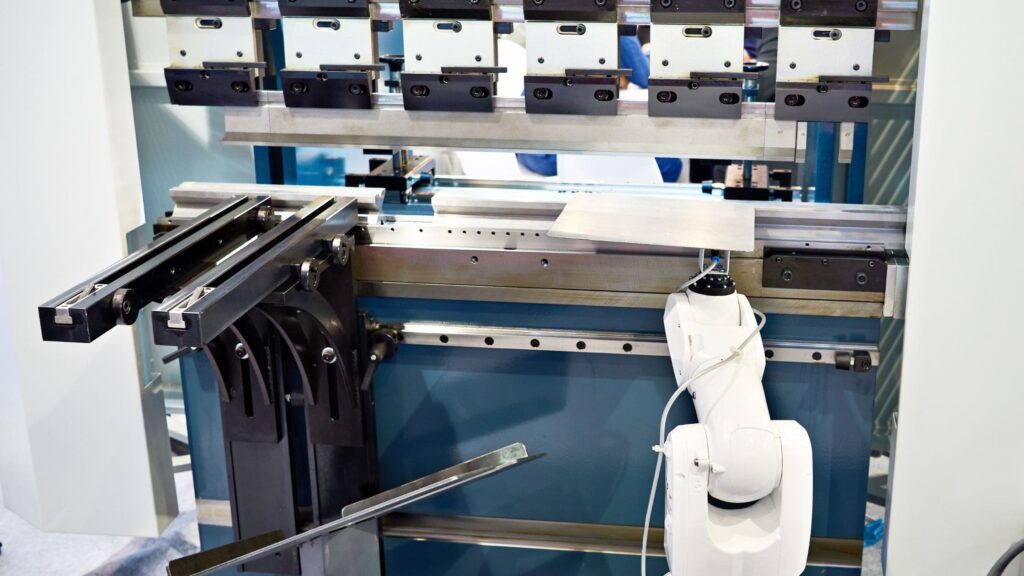
Press brake tooling is the equipment like dies and punches used in the press brake to create the bend in a sheet metal. Press brake tooling is not built into the machine. It is rather a swappable part of the machine that is used based on the particular type of job. Press brake tooling is the accessory that actually comes in contact with the workpiece.
What is the Main Purpose of Press Brake Tooling?
The main purpose of press brake tooling is to make the machine suitable for varying metal bending jobs. Without press brake tooling, one press brake machine will be very limited in the type, shape, and size of the bend it can perform.
However, press brake tooling expands the applications of the machine. Different bend angles and radii can be formed by simply changing the tooling. Therefore, press brake machines can quickly adapt to changing jobs.
What are the Key Elements of Press Brake Tooling?
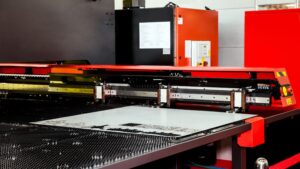
There are many different elements that work together for a press brake machine to work. These different elements are:
Top Tooling Types (Punches)
A punch is the tooling present on the top of the workpiece. It exerts the force on the workpiece that is necessary for the bend. It is extremely important to use good-quality punches since they are the central part responsible for exerting the force necessary in the metal bending process.
There are many types of punches available for different jobs. The punch selection should be made only after knowing the basics of each type of press brake punches. These different punches are:
Standard Punch
Standard punch is the most widely used press brake tooling. Its thicker body and narrow punch tip exert a higher tonnage that is useful for bending thickest material. The inward side has a slight concave curve with flat outsides. This provides the ability to fold a shorter flange.
Acute Angle Punch
Acute angle punch is used to bend very short angles. Acute angle punches are commonly shortened as acute punches. Usually, these punches are applied when the bend angle required is 30° or less. These punches can also easily bend larger angles such as 60°. These punches have a sharp tip with a generally bulky body.
Narrow Punch
A narrow punch is uniform throughout its length with a low thickness. These punches are used where there is a little clearance available and other punches might not fit easily. It is also known as a sword punch. A common application of a narrow punch is when closing off a square or box type profile.
Sash Punch
A sash punch is a type of tooling with a very narrow body and an angled tip that is bent towards the inside of a press brake. The angled tip provides the ability to work around corners and create bends. A common application of a sash punch is for making door jambs and sashes.
Swan Neck Punch
A swan neck punch is used for marking applications. They are used to create niche U profiles in the workpiece. The shape of the swan neck punch is specially created so the legs of the bent workpiece do not collide with the tooling. A variation of this style is the gooseneck punch, also used for U profiling. The niche shape of the swan neck and gooseneck punch creates an unsupported line of force. Therefore, these punches are weaker compared to other alternatives. They can handle a lower tonnage.
Joggle Punch
Joggle punch is a press brake special tool used for making bends around the corner. Joggle punch has a thinner profile, making it extremely useful for creating S-shape bends. These are not very common punches, often used for niche punch selection jobs.
Radius Top Punch
Radius top punch has a rounded tip instead of the sharp tips that other punches have. This creates a U-shape bend instead of a sharp V-shape bend. This punch is usually combined with a U-shape die for a properly-rounded corner.
Bottom Tooling Types (Dies)
A die is a hollowed tooling placed under a workpiece to provide support and precision for the bending process. Dies absorb all the force exerted by the punch. Therefore, these are also made of high-strength materials. Many different shapes and sizes of dies are available to suit various operations. Common die shapes are:
Single V Die
A single V die has a ‘V’ shaped cavity hollowed into the tooling. They are also stylized as single ‘Vee’ die. They are the most used press brake die due to their wide versatility. Single V die selection is done on the basis of rule of 8. It states that the length of the V die opening should be 8 times the material thickness.
Two-Way Self-Centring V Dies
Two way self centring V dies have two V-shaped cavities placed in parallel. This provides a faster workflow as compared to a single V die. There is no requirement for retooling in case another bend angle is required.
Multi V Die
Multi V die configurations have a number of V cavities arranged around the die. The number of V-cavities can range anywhere from 3 upwards. A multi V die adds the variety of bending options available in a single tooling. Changes in bend angle or material thickness can be accomplished by a simple rotation of the die.
Corrugating Dies
Corrugating dies have a corrugated pattern at the bottom. These dies are used in niche requirements where the bent sheet metal requires the same pattern on the outer surface.
Flattening & Hemming Dies
A flattening and hemming die is used to fold the entire flange length in an acute angle bend and flatten it completely. The bottom tool comes in two variations, namely sprung loaded and U-section bottom tool.
Channel Forming Dies
A channel forming die creates a ‘U’ shaped channel on a flat sheet metal. Creating a U-shape channel requires two passes of traditional V dies. However, a channel forming die can accomplish the job in a single pass.
Tool Holder
A press brake tool holder is a very useful accessory for mounting the tooling on the press brake. Modern tool holders come with productive features such as quick tool changes. A good quality tool holder also increases the precision of the bending process by minimizing tool vibration.
Backgauge
The backgauge of a press brake is used to precisely align the workpiece for an accurate bend. The backgauge is movable in the X-axis. The backgauge has multiple pieces of finger stops and blocks. These backstops will cease the bending process once the required bending length is achieved. A correct backgauge setup improves the repeatability and consistency of the press brake bending process.
Crowning System
A crowning system is a type of press brake tools that compensate for the deflection caused during the deformation of the ram and the workbench during the bending process. A crowning system is especially indispensable when it comes to large sheet metal bending due to the high deflection involved.
Efficiently using the crowning system requires an understanding of press brake deformation and deflection. There are two different types of crowning systems available: hydraulic crowning system and mechanical crowning system.
Press Brake Safety Devices
Press brake safety devices are secondary tools installed on the press brake for ensuring the safety of the operator, the workpiece, and the machine itself. Different press brake models come with different safety devices. Common press brake safety systems are:
- Laser Sentry: Laser sentry places multiple laser beams around the die. When any presence interrupts the laser beams, the laser sentry causes an immediate halt of machine operation and retracts the die. This provides a high level of safety to the operator and ensures that operator limbs aren’t harmed in the press brake work flow.
- Light Curtains: Light curtains are a common presence sensing device that provide automatic safety to the operator without any required setup. These work similar to the laser sentry system. When the flow of light curtains is interrupted, the safety system stops the machine operation at once without any delay.
- Guards: Press brake guards are present on the side and the rear end of the machine. Side guards prohibit the entry of operator arms or any foreign object between the die and the punch. Rear guards prohibit interference with the backgauge and other components behind the press brake.
- Two-Hand Control: Two-hand control requires the operator to use both hands to start the press brake cycle. This ensures that the operator does not accidentally start the machine when one of their hands is in between the die opening and the punch. Two-hand control is cheaper than laser sentry and light curtains. However, it slows the speed of the whole operation slightly.
What Material is Used For Making Press Brake Tooling?
Press brake tooling is usually made of special grade steel such as Yasuki Steel or Type 4 Molybdenum Steel. The punch and the die handle most of the force the press brake generates.
Therefore, it is vital to use high strength hardened steel to sustain this tonnage. Other common steel grades for making the right press brake tooling are T8 grade, T10 grade, 42CrMo grade, and Cr12MoV.
What is the best material for press brake tooling?
Chromium Molybdenum Steel (Chromoly) is considered the best material for press brake tooling. Chromoly steel has exceptional strength and corrosion resistance.
Therefore, it provides the ability to handle all press brake requirements and provide a long service life. Tungsten Carbide is another good option for press brake tooling, providing a high value of quality at a reasonable price.
The Three Main Styles For Press Brake Tooling

There are many different styles of press brake tooling. The three most common are:
American Standard Tooling
American-style tooling is the most popular variation of press brake tooling. It is the traditional style from North America. This style has a reduced surface area of the clamping mechanism. Successive swapping of the tooling reduces the precision in this style.
American-style tooling is cheaper than other styles of tooling. Generally, it is characterized by a 0.50-inch broad tang.
European Precision Style Tooling
European precision style tooling has a 13 mm wide tang and a rectangular groove on the side. This provides a high clamping pressure and a secure locking mechanism. Therefore, European tool style compatibility can achieve a high precision compared to other styles. This style is generally used in CNC press brake tooling.
Wila Trumpf Tooling System
Wila trumpf style tooling system uses a broader tang with 20 mm width and one groove each on the front and rear end of the tooling. This system provides an auto-clamping mechanism that seats itself in the right place. This provides high precision in the press brake operation. It is also known as the new standard tooling style.
The design of these tools supports a high-speed changeover mechanism. For light tooling under 27.6 lbs, a spring-loaded fast change button is installed. For heavier tooling, a pin-locking mechanism is used.
What are the Different Types of Press Brake Tooling?
There are many different types of tooling used in press brakes. These different press brake tools are:
Standard Punches and Die
Standard punch and die is the common tooling used for basic and simple press brake operations. Standard tooling is the go-to choice during air bending.
A ‘V’ shape profile is the most common for standard punch and die. However, sometimes ‘U’ shaped tooling is also used.
Radius Tooling
Radius tooling uses a rounded ‘U’ shaped punch. It is usually accompanied by a ‘V-shaped die. It is used in applications requiring a bigger bend radius than what can be achieved with a standard punch selection. This tooling most commonly uses the air bending technique.
Gooseneck Punch
A gooseneck punch is an angled punch with a hardened tip. It is used for making channels and Uprofiles in a workpiece. The special shape of the gooseneck punch eliminates any contact of the tooling with the workpiece flange length. There are many variations of gooseneck punches available for crafting special shapes. V-shape standard tooling is the most common option for a gooseneck die.
Sharp Bend Tooling
A sharp bend punch and die combination is used for bends of extremely small angles. These punches and dies have a tip angle of 30 degrees or less. Such punches are also known as knife punches.
Flattening and Hemming Tooling Set
A flattening tooling set is used when hemming of the bend is required. Flattening and hemming tooling set first creates a very sharp acute bend. The same tooling then creates the hemming for the bend. Therefore, this tooling set works in a 2-step process. This tooling type is limited in terms of material thickness.
Z Bend Tooling
Z-bend tooling is a set of special shape punch and die that creates a Z-bend in one pass. Standard tooling can also create Z-bends.
However, they require at least two passes to create a single Z-bend. This can be inconvenient for large-scale production. Z-bend tooling can speed up production by producing these bends in a single go.
What is the Typical Hardness of Press Brake Tooling?
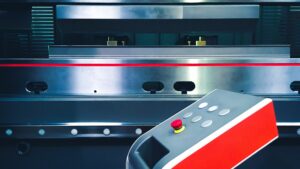
The typical hardness of press brake tooling is around 45 HRC (on the Rockwell scale). There are tooling sets available with an even higher hardness.
In comparison, the hardness of stainless steel is around 28 HRC. This is why press brake tooling can bend parts made of stainless steel and other materials so easily without incurring damage.
Significance of Press Brake Tools’ Hardness
The hardness of the press brake tooling does not indicate its tonnage. The hardness instead reflects the ability of the press brake to resist marks, scratches, and any indentations.
Indents can lead to internal defects that cause an early collapse of the press brake tools. To avoid this, tooling for press brakes is chosen of hardened steel and other similar or identical quality materials.
Why is the Importance of Choosing the Right Press Brake Tooling?
Making the right decision when choosing press brake tooling is crucial in every aspect. Press brake tools are the main component that absorbs the extreme forces of the machine operation. A wrong tool can easily break during operation resulting in a complete waste of investment.
Even if it doesn’t brake, the wrong tooling will definitely produce incorrect bends. It is often the case that choosing the wrong tooling can lead to breakage of the workpiece.
In some situations, the wrong tooling can even damage the machine itself. To prevent all these unwanted scenarios, it is vital to understand the press brake tools and make a careful choice based on the application.
Does tooling affect the accuracy of formed parts?
Yes, press brake tool selection plays the deciding role towards the accuracy of the sheet metal formed parts. Choosing the wrong type of press brake will lead to the wrong shapes of the bend.
Additionally, the bend angle of the workpiece depends on the angle of the punch (in case of air bending) and punch and die (in case of bottoming). Tools such as the back gauge further enhance the precision of the sheet metal forming operation.
How to Choose the Right Press Brake Tooling?
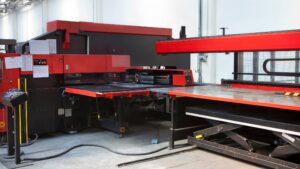
Choosing press brake tooling should be done based on the evaluation of the factors below:
Type of Material
The type of material is the primary factor that influences the tooling. Certain materials have low flexibility and high hardness and require higher quality tooling because of the difficulty in bending. These difficult materials also have the tendency to degrade tooling at a faster rate.
Material Thickness
The material thickness influences the size of the tooling you will need. The major factors derived from material thickness are the press brake die opening size, the bending angle, and bending radius. Thicker materials will limit the bending angle possible, making sharp bends difficult.
Additionally, thicker materials will require a higher bending radius, meaning a bigger die opening.
The die opening follows the rule of 8. This rule recommends that the size of the die opening should be eight times the material thickness.
An important thing to note is that this is the recommended value for most cases, not the ideal value. Certain situations might require a bigger or smaller die opening size.
Length of Workpiece
The length of the workpiece influences the size of the tooling. The two important considerations regarding length are the minimum flange length and the maximum flange length.
The die opening should be small enough to accommodate the minimum flange length. If the die opening is bigger, the flange will fall into the die cavity. Large flange length requires bigger tooling or additional tools. The punch size must be sufficient so that the maximum length does not cause damage to the machine parts.
Bend Angle
The bend angle influences the angle of the punch tip and its thickness. Large bend angles can use thicker punches. However, very sharp angles require special equipment like the acute offset knife punch and matching dies.
Bend Radius
Stronger materials require a bigger bend radius. The bigger bend radius is possible only with a bigger die opening. The ratio between the bend radius and the die opening depends on the type of material being used.
In the case of mild steel, it is important to keep the bend radius equal to V/8, where V is the open die width. Materials stronger than mild steel will have a higher value of bend radius. Therefore, the denominator will have a smaller value than 8.
Bend Shape
The shape of the bend decides which punch and die to use. There are many different types of tooling and each creates a specific bend shape. Many bend shapes have multiple tooling options. The right press brake tooling will provide the particular shape in the least amount of passes. For instance, a Z shape bend requires two passes through a V-shape die. However, it requires only one pass through a Z-bend tooling.
Type of Bending
There are three different types of bending, namely air bending, bottoming, and coining. Not every tooling is suitable for all of these three types.
Decide which type of bending process you will use to shortlist the available tooling options for you. For instance, standard-size tools are good for classic air bending techniques.
Budget
The budgetary constraints determine the tooling material you can use. Expensive tooling materials can seem like a bigger investment but will provide a longer service life. Remember to include the cost of accessories, such as the tool holders, when evaluating the tooling price.
Tooling Brand
Choosing a popular and reliable tooling brand is better since it is integral to the whole process. Tooling manufactured by reliable brands considers problems such as denting and deformation. Branded tools tend to have better honing and longer life.
Production Volume
Special and niche tooling is better for large production volumes. This is because these toolings can produce the required bend in fewer passes.
It exponentially speeds up the whole production process. However, low scale production can make use of standard tooling if they can create the required bends.
Press Brake Compatibility
There are many different styles of tooling for press brakes. Choosing the style and design that is compatible with the press brake you have. Refer to the press brake manufacturer manual to find out the correct tools for your machine.
Tonnage Capacity
Press brake dies and punches come with a tonnage capacity rating. Choose dies that have this rating more than the tonnage you will apply on the job. Choosing low tonnage press brake dies and punches in a high tonnage operation will lead to the breakdown of the tooling.
How to Calculate Press Brake Tooling Parameters?
Using a press brake requires knowledge of the various associated parameters and how to calculate them. Here are these important parameters and their formulas:
- K Factor: The K factor is a property of the workpiece material that depicts its ability to stretch. This value can be found on reference charts for your particular workpiece material.
- Bending Force: Bending force is the approximate force you need to bend a material. This force is calculated with the formula F = K x W x T x UTS; where F is the bending force, K is the K-factor, W is the width of material, T is the material thickness, and UTS is the ultimate tensile strength.
- Minimum Flange Length: The minimum flange length is derived from the formulae Flange length min = 8 x T; where T is the material thickness.
- Inside Bend Radius: The inside bend radius is calculated from the formula Internal Radius = Die Width – (T/2); where T is the material thickness.
How to Maintain and Store Press Brake Tooling?

Press brake tooling can last way beyond its expected service life with the right maintenance and tooling schedule. Some tips in this regard are:
- Cleaning: Cleaning is the golden rule of press brake toolings. Many users store their press brake without removing the grease, dirt, and other contaminants. This increases the tool wear and can even cause corrosion. Therefore, wipe the press brake tooling at the end of every workday. Use the cleaning solutions that the tooling manufacturer recommends.
- Sharpening: The sharpness of tooling is very important for press brake operation. However, this sharpness can dull after a certain time. Follow proper resharpening and reconditioning measures on time. Dull tooling edges lead to increased wear and poor precision.
- Lubrication: Before starting the operation, apply a lubricant on the tool to reduce the friction between parts. The right choice of lubricant will be suggested in the manufacturer’s guide for the tooling.
- Rated Limits: Using the tooling within its rated limit capacity is crucial. Going overboard can immediately break down the tooling and even the machine.
- Storage Environment: Ensure that the storing conditions for the tooling are free from any moisture or chemical contaminants.
- Tooling Cabinet: It is best to have a dedicated tooling cabinet for your press brake toolings. This cabinet can be placed near the machine itself for a smooth workflow.
- Tool Replacement: Check the tooling for any sign of damage, cracks, or significant wear. Replace the tooling when necessary. Using tooling in damaged health will create subpar bends.
Where to Buy Press Brake Tooling?
Accurl is the leading marketplace for all types of press brake toolings. Accurl tooling solutions are used in press brakes of all ranges, from basic machines to high-end equipment. In addition to tooling, Accurl also provides tool storage solutions with convenient loading and unloading mechanisms.
These illuminated tool storage solutions allow you to organize all your press brake toolings and find them promptly when required. The color of these solutions can be customized based on your requirements.
Endnotes
With the information provided above, you can now choose between the different types of toolings for any job requirement. It will improve the quality of your bends and speed up the whole bending operation.
Regardless of what type of tooling you use, do follow our maintenance recommendations to get the best return on your investment. Get in touch with Accurl to get a quote for your tooling requirements.


